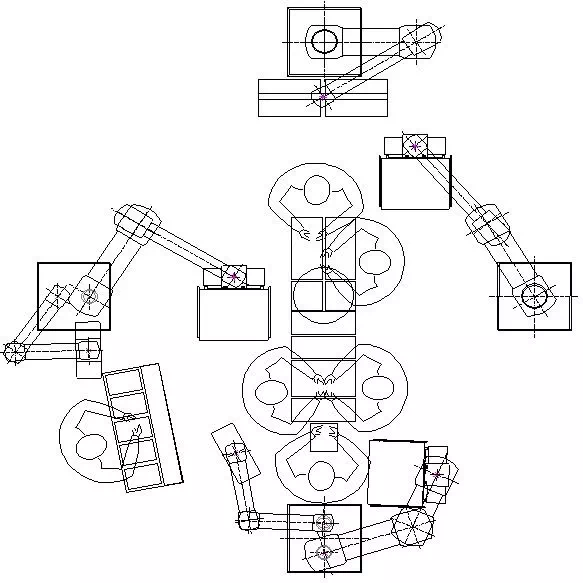When a surgery begins, in addition to different medical staff around the patient, such as the surgeon and his assistants, nurses, there will also be various necessary medical equipment and instruments. The area of a general sterile operating room does not exceed 40 square meters.
In China, sterile surgical rooms are strictly restricted areas. Generally, operating rooms can be divided into three areas based on cleanliness: restricted area, semi restricted area, and non restricted area. Personnel entering restricted areas must strictly adhere to the principle of sterility in their activities, except for changing into operating room clothes, shoes, and wearing specialized hats and masks. The management of medical equipment and devices is also very strict.
Therefore, in addition to selecting and positioning the suspension tower according to the operating room process, if the working area of medical staff and equipment can also be considered, medical equipment can be more reasonably placed during surgery, and medical staff can carry out surgery more effectively.
The design of work areas generally considers the operating area of the operating room and the usage habits of surgical personnel.
1. Surgical area
According to the medical staff and the required medical equipment, the surgical area can be distinguished, and the main types are as follows:
Anesthesia area. Generally located on the patient's head side, it is convenient for anesthesiologists to take care of the patient, monitor vital signs, adjust anesthesia parameters, record anesthesia information, etc. The hanging tower involves the use of medical equipment such as anesthesia machines, negative pressure suction devices, infusion pumps, monitors, monitors, heating blanket controllers, blood gas analyzers, etc
Surgical area. Generally located on the patient's foot, surgeons and assistants can promptly obtain the medical equipment required during the surgical process. The lifting tower involves the use of medical equipment such as high-frequency electric knives, ultrasonic knives, negative pressure suction devices, defibrillators, electrocardiographs, etc
Endoscopic area. According to the needs of laparoscopic surgery, it is generally located on the patient's waist ventral side for centralized management of laparoscopic surgical equipment. The hanging tower involves the use of medical equipment such as pneumoperitoneum machine, cold light source, laparoscopic console, monitor, and recording console
Other areas. Determine based on specific medical equipment, such as extracorporeal circulation machines, additional monitors, etc
2. Usage habits
During the surgery, the personnel involved are generally anesthesiologists, chief surgeons, primary and secondary assistants, hand washing nurses, and tour nurses. If encountering more complex surgeries, there may be participation from three assistants and four assistants, or other teams may rotate and participate. Therefore, considering the usage habits of the main surgical personnel is very important, including the habit of using suspension towers and the habit of using medical equipment.
For example, the following diagram shows the positioning plan of a more complex cardiac surgery suspension tower.
A double tower has been installed at the anesthesiologist's location on the patient's head. Considering the habits of the anesthesiologist's left and right hands and the workflow during surgery, the left tower is used to place infusion equipment, while the right tower is used to fix the anesthesia machine and monitor. This facilitates the anesthesiologist to monitor the patient's vital signs, record anesthesia information, and adjust anesthesia parameters.
Two suspension towers were installed on the patient's foot for the ultrasound team. The suspension tower on the right side of the picture provides gas and electricity supply for the ultrasound equipment, and can also be used in conjunction with some surgical tools. Doctors can select the necessary tools in a timely manner during the surgery process; The hanging tower above the picture is equipped with multiple displays, which facilitate the cardiac surgery team and ultrasound team to simultaneously view the required information such as ultrasound images, patient medical records, vital signs, etc. during the surgical process.
A set of double towers was installed on the patient's waist and abdomen, located on the left side of the picture. The left hanging tower provides corresponding supply for the extracorporeal circulation machine below; The hanging tower on the right takes into account the surgical tools required by the cardiac surgery team during the surgery process, such as electric knives.
The above briefly introduces the selection and positioning of suspension towers based on the habits of different medical staff. In fact, the usage habits of most medical staff do not have a unified commonality, so when confirming the positioning of the suspension tower, it is necessary to communicate as much as possible with the main operating medical staff in a more detailed manner. At the same time, auxiliary tools can be used to help understand, such as through graphic explanations, 3D demonstrations, or operating between physical objects.Article SourceSAKAMITI-https://www.sakamiti.com/2212.html
Article SourceSAKAMITI-https://www.sakamiti.com/2212.html
文章末尾固定信息



